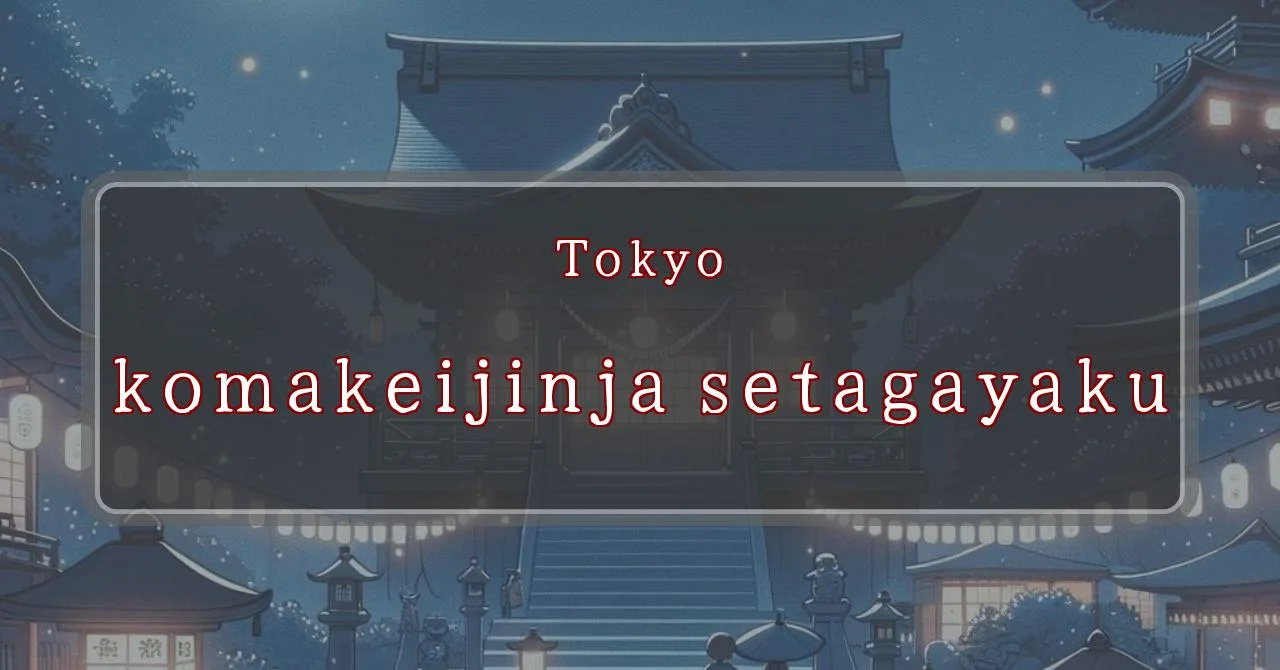Enchanting lights, divine spirits, and ancient traditions await.
Basic Information
Koma-tsuna-gi Shrine is a Shinto shrine located in Shimoma, Setagaya Ward, Tokyo, Japan. It is dedicated to the deity Okuninushi no Mikoto, also known as the god of good fortune and縁結び (enmusubi), or matchmaking.
- Address: 4-27-26 Shimoma, Setagaya-ku, Tokyo 154-0002
- Phone Number: 03-3414-8369
- Access: 5-minute walk from Shimoma 1-chome bus stop, Tokyu Bus from Shibuya Station; 3-minute walk from Koma-tsuna-gi Jinja bus stop, Tokyu Bus from Shibuya Station; 15-minute walk from Yutenji Station, Tokyu Toyoko Line; 20-minute walk from Sangenjaya Station, Tokyu Den-en-toshi Line
- Festival Days: Third Sunday of September
Main Events and Attractions of the Festival
The Koma-tsuna-gi Shrine Festival is an annual event that takes place on the third Sunday of September. It is a lively and colorful festival that attracts many visitors from all over Tokyo and beyond.
Mikoshi Procession
One of the main highlights of the festival is the mikoshi procession. A mikoshi is a portable shrine that is carried through the streets by a team of people. The Koma-tsuna-gi Shrine mikoshi is particularly impressive, as it is decorated with elaborate carvings and ornaments. The procession is accompanied by music and dancing, and it is a truly festive sight to behold.
Kagura Performance
Another popular attraction at the festival is the kagura performance. Kagura is a traditional Japanese dance that is performed to Shinto music. The dances are often very elaborate and colorful, and they tell stories from Japanese mythology. The Koma-tsuna-gi Shrine kagura performance is one of the most popular in Tokyo, and it is a must-see for any visitor to the festival.
Food and Games
In addition to the mikoshi procession and kagura performance, the Koma-tsuna-gi Shrine Festival also features a variety of food and games. There are stalls selling everything from traditional Japanese dishes to international cuisine. There are also games for children and adults of all ages. The festival is a great place to enjoy a day out with family and friends.
gi Shrine is dedicated to the deity Okuninushi no Mikoto, also known as the god of good fortune and 縁結び (enmusubi), or matchmaking. Okuninushi no Mikoto is one of the most popular and widely worshipped deities in Japan, and he is said to bestow blessings of good luck, prosperity, and happiness upon those who pray to him.
- Deity: Okuninushi no Mikoto
- Blessings: Good luck, prosperity, happiness, matchmaking
Origin and History
The origins of Koma-tsuna-gi Shrine are unclear, but it is believed to have been founded sometime during the Heian period (794-1185). The shrine is mentioned in several historical documents, including the “Engishiki” (延喜式), a record of Shinto shrines compiled in the 10th century. Koma-tsuna-gi Shrine was originally known as “Ko no Kami” (子の神), but it was renamed to its current name in the Meiji period (1868-1912).
- Founded: Heian period (794-1185)
- Original name: Ko no Kami (子の神)
- Current name: Koma-tsuna-gi Shrine
Tips and Notes for Visitors
Here are some tips and notes for visitors to Koma-tsuna-gi Shrine:
- The shrine is open daily from 9:00 AM to 5:00 PM.
- Admission is free.
- The shrine is a popular destination for weddings and other ceremonies, so it is best to visit on a weekday if you want to avoid crowds.
- There is a small parking lot available for visitors.
- The shrine is located in a quiet residential neighborhood, so please be respectful of the local residents.
Parking Information
There is a small parking lot available for visitors to Koma-tsuna-gi Shrine. The parking lot is located behind the shrine, and it can accommodate up to three cars. The parking fee is 500 yen per day.
Popular Stalls and Food Carts in Recent Years
| Type of Stall | Description |
|---|---|
| Takoyaki | A staple at Japanese festivals. Characterized by a crispy outside and a creamy inside. |
| Jaga Butter | A simple yet popular snack of hot potatoes lavishly topped with melted butter. |
| Baby Castella | Small castella cakes, sweet and fluffy treats enjoyed by children and adults alike. |
| Grilled Ayu with Salt | Fresh ayu fish grilled whole with salt, a savory taste of Japanese summer. |
| Shaapin | A unique gourmet item influenced by foreign cuisine, with a chewy skin wrapping the filling. |
| Okonomiyaki | A Japanese grilled dish where you often choose your own ingredients for a personalized flavor. |
| Cotton Candy | A fluffy, sweet snack that’s extremely popular with children. |
| Chocolate Banana | A banana coated in chocolate, a fun and visually appealing dessert. |
| Kushiyaki | Various types of ingredients skewered and grilled, an easy-to-enjoy snack. |
| Yakisoba | Fried noodles mixed with a special sauce, a fast food favorite in Japan. |



